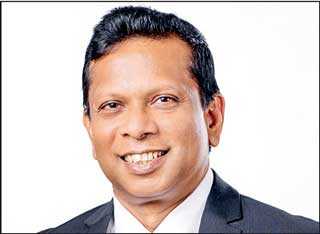Sunday Dec 15, 2024
Sunday Dec 15, 2024
Friday, 2 April 2021 00:00 - - {{hitsCtrl.values.hits}}

 |
| GRI Chief Executive Officer Dr. Mahesha Ranasoma
|
What does it mean for a specialist tire manufacturer to innovate? How can a company embed innovation into its DNA? As a leading producer of specialty tires, innovation goes far beyond the final product for GRI.
“The future outlook for the specialty tire market is a robust one. New technologies, business agility and innovations can yield vast opportunities for growth for players in the industry. While technology and innovation go hand in hand, it is important to remember that this is only one driver of innovation. Innovation is a holistic process that encompasses all parts of a business’ operations,” commented GRI Chief Executive Officer Dr. Mahesha Ranasoma.
For GRI, innovation began at the outset of its journey setting a sturdy foundation to build on. Its mission was to produce tires that would challenge the best tire producers in the world. The company began by installing cutting edge technology and equipment that was best in class. Some equipment was the first of its kind in Sri Lanka. And GRI expanded their R&D capabilities in both its factories, employing skilled personnel who were the best at what they do.
These initial steps to incorporate innovation in its production and development have yielded results. GRI has focused innovation in designs and compounds, developing new tread patterns and advanced compounds that give a higher performance at the same costs. This has enabled GRI to serve customers better, creating high demand for its products in both solid and pneumatic specialty tires, resulting in the expansion of both its factories.
Agility in innovation can be seen in GRI’s ability to persistently add value to its customers. A recent development in its solid tires was a special tire with a wider footprint but the same weight and structure. GRI also worked collaboratively with its Japanese customer to produce a winter tire with a special compound and tread that functions in sub-zero temperatures.
GRI also innovates through its processes and systems. Employees are encouraged to think out of the box and develop new ways of working to increase efficiency, find new ways of servicing their diverse clientele and adding value at every stage.
Innovation in sustainability is another driver at GRI. Sustainable business is at the heart of its operations. GRI is a global stakeholder actively adapting and aligning its practices and policies in accordance with UN Sustainability Development Goals and incorporating eco-friendly innovations across the board. Environmental sustainability and innovations in this regard are key thrusts throughout GRI organisation.
When GRI initiates a development, it looks at whether it would reduce its carbon footprint and if it leads to a reduction in wastage and better recyclability. The company focuses on ensuring there is a reduction in the customer’s carbon footprint as well – energy consumption also decreases thanks to the use of GRI Tires. Even within GRI’s own manufacturing systems, it looks at energy efficiency. GRI’s innovation has a firm sustainability foundation.
While natural rubber is a renewable commodity, in an industry where demand is disproportionately large, sustainability in sourcing is of foremost importance. GRI sources pure natural rubber from Sri Lankan farmers and plantations around the island nation. This natural rubber, which is sourced from smallholder rubber farmers in Sri Lanka to build GRI’s high-grade Agriculture Tires that are eventually fitted on the machinery of farmers across the world, creates a unique value chain which begins and ends from one farmer to another.
GRI’s GREEN X circle highlights this unique linkage creating an end-to-end farmer eco-system between Sri Lankan rubber farmers who harvest natural rubber and the agricultural farmers worldwide who use tires made from this natural rubber. This is an example where creative thinking on innovation and sustainability connect in an end-to-end manner. GRI uses innovation to push different boundaries beyond the product.
“Our focus is to develop products that function above anticipated performance and are always made at the upper limits of performance and quality tolerance. This guarantees the utility value to the end-user beyond what they expect. It leads to our virtuous cycle of continuously increasing the customer’s value creation boundaries. Innovation is an everyday process of continuous improvement. We at GRI are proud to say that innovation is truly in our DNA,” said Dr. Mahesha Ranasoma.